The other answer is fine but you don't really need to involve flow as this can be reduced just as well to ordinary maximum bipartite matching:
- For each plane, add another auxiliary plane to the plane partition with edges to the same pilots as the first plane.
- Find a maximum bipartite matching M.
- The answer is now true if and only if M = 2 N.
If you like, you can think of this as saying that each plane needs a pilot and a co-pilot, and the two vertices associated to each plane now represents those two roles.
The reduction to maximum bipartite matching is linear time, so using e.g. the Hopcroft–Karp algorithm to find the matching, you can solve the problem in O(|E| √|V|) where E is the number of edges between the partitions, and V = T + N.
In practice, the improvement over using a maximum flow based approach should depend on the quality of your implementations as well as the particular choice of representation of the graph, but chances are that you're better off this way.
Implementation example
To illustrate the last point, let's give an idea of how the two reductions could look in practice. One representation of a graph that's often useful due to its built-in memory locality is that of a CSR matrix, so let us assume that the input is such a matrix, whose rows correspond to the planes, and whose columns correspond to the pilots.
We will use the Python library SciPy which comes with algorithms for both maximum bipartite matching and maximum flow, and which works with CSR matrix representations for graphs under the hood.
In the algorithm given above, we will then need to construct the biadjacency matrix of the graph with the additional vertices added. This is nothing but the result of stacking the input matrix on top of itself, which is straightforward to phrase in terms of the CSR data structures: Following Wikipedia's notation, COL_INDEX should just be repeated, and ROW_INDEX should be replaced with ROW_INDEX concatenated with a copy of ROW_INDEX in which all elements are increased by the final element of ROW_INDEX.
In SciPy, a complete implementation which answers yes or no to the problem in OP would look as follows:
import numpy as np
from scipy.sparse.csgraph import maximum_bipartite_matching
def reduce_to_max_matching(a):
i, j = a.shape
data = np.ones(a.nnz * 2, dtype=bool)
indices = np.concatenate([a.indices, a.indices])
indptr = np.concatenate([a.indptr, a.indptr[1:] + a.indptr[-1]])
graph = csr_matrix((data, indices, indptr), shape=(2*i, j))
return (maximum_bipartite_matching(graph) != -1).sum() == 2 * i
In the maximum flow approach given by @HeatherGuarnera's answer, we will need to set up the full adjacency matrix of the new graph. This is also relatively straightforward; the input matrix will appear as a certain submatrix of the adjacency matrix, and we need to add a row for the source vertex and a column for the target. The example section of the documentation for SciPy's max flow solver actually contains an illustration of what this looks like in practice. Adopting this, a complete solution looks as follows:
import numpy as np
from scipy.sparse.csgraph import maximum_flow
def reduce_to_max_flow(a):
i, j = a.shape
n = a.nnz
data = np.concatenate([2*np.ones(i, dtype=int), np.ones(n + j, dtype=int)])
indices = np.concatenate([np.arange(1, i + 1),
a.indices + i + 1,
np.repeat(i + j + 1, j)])
indptr = np.concatenate([[0],
a.indptr + i,
np.arange(n + i + 1, n + i + j + 1),
[n + i + j]])
graph = csr_matrix((data, indices, indptr), shape=(2+i+j, 2+i+j))
flow = maximum_flow(graph, 0, graph.shape[0]-1)
return flow.flow_value == 2*i
Let us compare the timings of the two approaches on a single example consisting of 40 planes and 100 pilots, on a graph whose edge density is 0.1:
from scipy.sparse import random
inp = random(40, 100, density=.1, format='csr', dtype=bool)
%timeit reduce_to_max_matching(inp) # 191 µs ± 3.57 µs per loop
%timeit reduce_to_max_flow(inp) # 1.29 ms ± 20.1 µs per loop
The matching-based approach is faster, but not by a crazy amount. On larger problems, we'll start to see the advantages of using matching instead; with 400 planes and 1000 pilots:
inp = random(400, 1000, density=.1, format='csr', dtype=bool)
%timeit reduce_to_max_matching(inp) # 473 µs ± 5.52 µs per loop
%timeit reduce_to_max_flow(inp) # 68.9 ms ± 555 µs per loop
Again, this exact comparison relies on the use of specific predefined solvers from SciPy and how those are implemented, but if nothing else, this hints that simpler is better.
